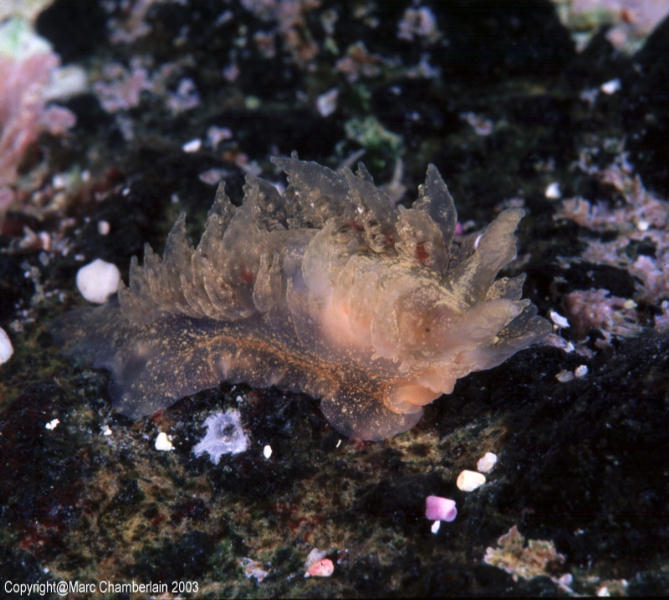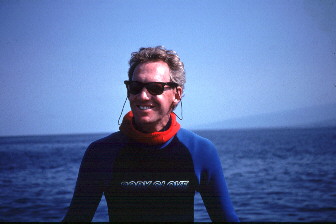 |
Dirona picta
Photo Courtesy of Marc ChamberlainDirona picta is one of my favorite California species. I will never forget the day I found my first specimen on the power plant intake structure of the Morro Bay Power Plant. The 30 mm specimen was so cryptic among the thick growth of bryozoans and other grunge that I am surprised I detected it.
A member of the suborder Arminacea, Dirona picta is quite variable in color and body texture. Pacific Coast Nudibranchs shows three colors on page 81, ranging from cream through red and a spectacular green specimen collected by Terry Gosliner. The body and cerata are often covered with varying colored spots and blotches. Marc's specimen from Santa Barbara Island, in the California Channel Islands is quite typical of the translucent cream color variety. Another shot by Mike Miller shows how inflated the cerata-like dorsal processes can be and the very typical irregular tuberculate texture of their surface.
Years ago Webmaster Miller was diving on a wreck near San Diego with the University of California at San Diego Dive Club when they found literally hundreds of specimens having the characteristic wide frontal veil and showing the characteristic white stripe up each rhinophore, but with smooth cerata. I sometimes wonder if these critters are a new undescribed species or if they are the sister species, Dirona albolineata just without the white line along the edge of the cerata.
As indicated by the authors' names listed behind the name Dirona picta , this species is one of those few that has caused confusion in the literature because its original description was a subsection (written by Dr. Frank Mace MacFarland) in a large monograph authored by Drs. Cockerell & Eliot, back in 1905.
This species, like others in the genus, feeds on arborescent bryozoans, in particular
Scrupocellaria californica.
D. picta previously recorded north to Charleston, Oregon, has recently been collected on the south side of Cape Mearnes, Tillamook County, Oregon (Jeff Goddard, pers. comm.). At the southern end of its range it is know to occur to Puerto Rompiente, Baja California Sur, Mexico. Dr. Hans Bertsch has found several specimens of Dirona picta during his years of diving at Bahia de los Angeles, Baja California. This
small
one was found 28 November 1992, on its encrusting bryozoan prey item. Note the extremely good protective camouflaging coloration this species exhibits. On 25 June 1998, Hans, while diving with Alan Grant and Herr WebMeister Mike, he photographed a
large specimen crawling over the alga Padina which, like other species of algae, is quite common at this time of year.
The species is also known from the Gulf of Japan.
Danville, Calif
Feb . 2003

Send Marc mail at chamberl@usc.edu |
Taxonomic information courtesy of:

David W. Behrens
Author:
Pacific Coast Nudibranchs
Send Dave mail at info@seachallengers.com
|
